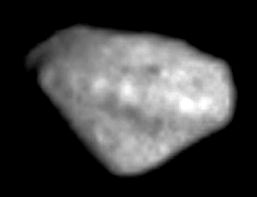|

by Richard C. Hoagland
2008
from
TheEnterpriseMission Website
The evening of September 5, 2008, ESA
(the European Space Agency) successfully flew its unmanned
"Rosetta" spacecraft within 500-miles of a tiny (~ 3 miles across),
newly-discovered (1969) asteroid, known as "2867 Steins." The
diminutive asteroid was not the prime objective of Rosetta's
eleven-year projected Mission... but only an interim "port of call"
(one of two asteroid fly-bys on Rosetta's highly involved itinerary
- see below).
The real objective of the 3-ton European spacecraft, launched in
2004, is an unprecedented deep space chase - involving three
repeated encounters with the Earth, one of Mars... and the two
aforementioned asteroid fly-bys... all carried out enroute to the
ultimate target of the Mission...
The eventual rendezvous (and orbit, with touchdown of another small,
sub-spacecraft - called "Philae")... of a small periodic comet
orbiting the Sun in a 6.6-year, highly elliptical orbit (German
diagram - below) -
Comet 67P/Churyumov- Gerasimenko.
Said rendezvous to be achieved in... 2014.
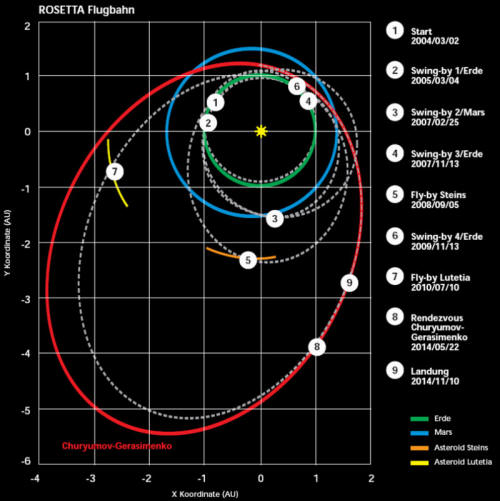
The "opportunistic" Rosetta encounter
with the asteroid "Steins" (which "just happened" to lie along the
complicated route to the real Mission objective - the comet
rendezvous with 67P), thus represented both an early scientific and
"operations" bonus for Rosetta... as well as something of a risk.
Yes, future 2014 spacecraft observations at the comet could be
substantially enhanced by the practice gained during the initial
Steins asteroid fly-by in 2008 (and, the other asteroid, "Lutetia,"
in 2009), but taking science data from such objects was never built
into the original spacecraft design.
So, mission operations at
Steins (which were expected to involve several highly unusual
spacecraft maneuvers... below) could have actually resulted in
physical damage to the spacecraft (or its instruments) during the
improvised encounter!
For this reason, Rosetta Mission designers initially planned to
simply fly-by asteroid 2867 Steins "in the blind"... taking NO
science data during the time of actual Closest Approach!
However, this post-encounter morning - September 6, 2008 - there
will be an ESA "Steins science press conference" after all, to be
held at Rosetta's European Space Operations Centre (ESOC) in
Darmstadt, Germany.
At this press briefing, results of scientific
data taken during that encounter will, in fact, be presented; one of
the reports being that,
"the Rosetta spacecraft came through
[the Encounter] with flying colors..."
as noted by Dr. David Southwood, ESA's Director of Science and Robotic Exploration. "... Steins might be small, but
we're making big science here", said Southwood.
"The better we
learn to know the different kinds of asteroids, the better we
will understand our origins in the past. Moreover, when such
Solar System wanderers escape from the belt they could become a
threat to Earth. The better we know them, the better we will be
able to mitigate the risks some of them might present in the
future."
This glowing assessment of the Rosetta
fly-by, however, initially neglected to mention one significant
"detail".
The mysterious and immensely disappointing electronic cut-off of the
spacecraft's only Narrow-Angle Camera (NAC)... some nine minutes
(and more than 3000 miles) BEFORE the closest approach of the
spacecraft to the asteroid!
"The software switched off
automatically," said Gerhard Schwehm, the Mission Manager and
head of Solar Systems Science Operations at ESA. "The camera has
some software limits and we'll analyze why this happened
later...."
This completely unexpected (and hugely
disappointing) "software glitch" resulted in a loss of ALL the
highest-resolution imaging data from Rosetta (including
high-resolution multi-spectral and color views) of "2867 Steins" -
leaving only the five-times-lower-resolution Wide Angle Camera (WAC)
data for visual analysis.
However, even in these lower-resolution WAC images, it was
immediately apparent that "2867 Steins" was a "curious object"
indeed; its overall appearance (below, left) was intensely
"geometric" - resembling nothing as much (freely touted in the
official ESA press releases) as "a diamond in the sky" (below,
right)... complete with facets!

This extraordinary first impression is
easily confirmed by a quantative geometric comparison (below)....
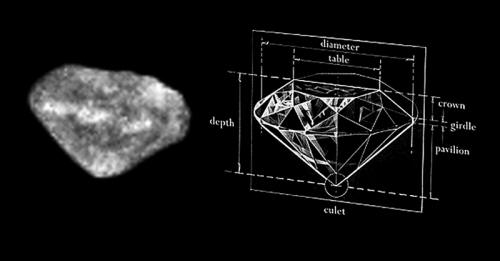
This 2-D appearance is further
substantiated by the 3-D "anaglyphs" the Rosetta team prepared and
conveniently posted on their website (get out your red/green glasses
- below).
Steins really IS a 3-D "diamond in the sky."
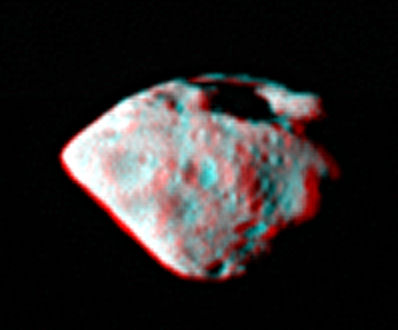
Naturally, when geometric-looking objects are imaged in space - by
either NASA, or (now) by various other space agencies around the
world - we here at Enterprise, who have relied upon geometric
criteria in our research for almost three decades now, pay more than
casual attention...
For, as the late Dr.
Carl Sagan so famously noted:
"Intelligent life on Earth first
reveals itself through the geometric regularity of its
constructions...."
Carl Sagan, "Cosmos"
(Random House, 1980)
This dictim has been the single most
reliable archaeological indicator of "ancient ruins" here on
Earth... for over a hundred years.
[Below: note the difference
between recently excavated ruins at Armana, Egypt in this satellite
image (casting sharp, "rectilinear" shadows from "newly dug-out
walls and other vertical structures")... and those ruins still
buried under the sands (evidenced by muted, but still equally
rectilinear surface outlines...)].
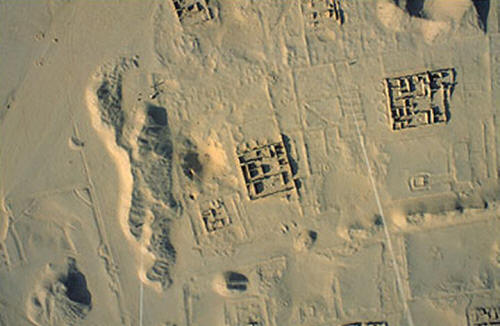
As readers of Enterprise well know, this baseline archaeological
standard of "intelligence" on this planet has been the core
foundation of our ~30-year-long investigation into NASA (and other )
imagery of potential "ancient intelligent ruins" located on other
planets in this solar system (such as this startling example of
identical "raised rectilinear geometry"
photographed on Mars by
NASA's Mars Surveyor - below)...
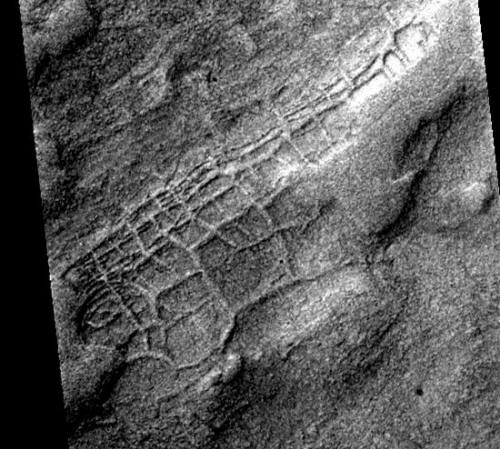
By far, the ultimate expression of this "geometric intelligence
criterion" was our discovery, just a few years ago, that an entire
outer solar system object seems to follow this essential "geometric
intelligence criterion":
Iapteus - the third largest satellite in the Saturn system - was
imaged in 2004 by
NASA's Cassini Mission; on the best Iapetus images
sent back to Earth, the distinct, straight-edged, highly geometric
outline of this entire ~900-mile-diameter "moon" is strikingly,
blatantly apparent (below).
An astonishing, inescapable, major solar system anomaly - still...
totally ignored by NASA - even as its extraordinary implications
have been thoroughly and scientifically
addressed by Enterprise...
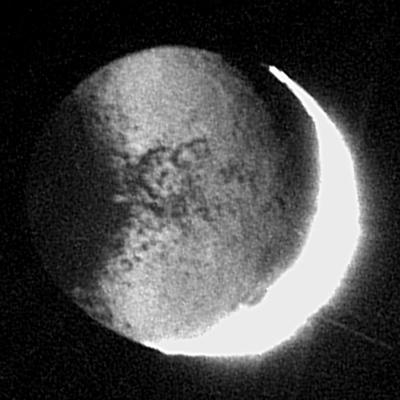
With this as backdrop, when the startling, highly-regular
"diamond-shaped" images of tiny "2867 Steins" first appeared on the
official ESA website, we couldn't help but wonder.
"Could this, too, be an ancient,
artificial solar system object... and not an 'asteroid' at all!?
Could ESA have been that lucky... on its first time out?"
However, a detailed look at the initial
data (below) was very disappointing; not only were the Closest
Approach images NOT "high resolution"... they appeared severely
compromised by a variety of (also suspiciously "geometric"...),
highly amateurish-looking "imaging artifacts!"
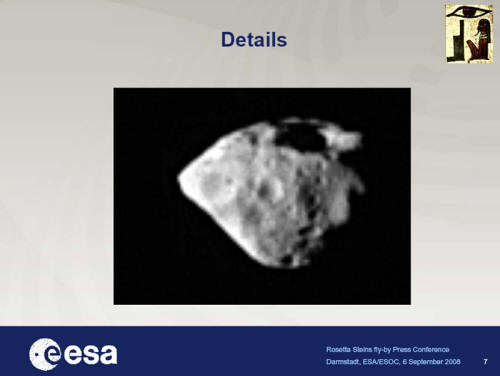
In short, given the spacecraft trajectory and
published capabilities
of even its Wide-Angle Camera, we expected a LOT more from the ESA
"Steins" encounter....
Some background:
All the
released images taken by Rosetta were acquired according to
previously uplinked computer commands, stored on-board - updated by
the latest navigation information. In turn, these computer
instructions (at the appropriate time) commanded the spacecraft to
autonomously reorient itself in space, before the actual fly-by, in
such a way that, during those critical few minutes of Closest
Approach, the entire spacecraft (relative to the Sun and Steins)
physically "flipped itself" in space.
This maneuver allowed Rosetta to track the radically changing
geometric relationship of the asteroid... relative to the
spacecraft... in "real time," so that the cameras (and other
on-board sensors) remained pointed directly toward the tiny,
high-velocity target... even as the sun-angle and pointing direction
in space changed radically in those critical few minutes (below).

This daring (and, until September 5th, totally untested) set of
complex spacecraft maneuvers was
initially rejected by Rosetta
Mission planners as "too dangerous" for the long-term Mission. This
concern was due primarily to undue thermal stresses such a maneuver
would have placed on the spacecraft and its instruments - by
rotating their electronics toward the Sun "in those critical few
minutes."
However in the end, curiously, the maneuver was ultimately deemed
"an acceptable risk" after all....
Taking that spacecraft risk (however large or small...) resulted in
a complete visual record of the Encounter (at least, in Wide-Angle
imaging...), as well as data from about 14 other on-board
instruments, which the ESA scientists said they planned to use in
"characterizing the chemical composition" of "2867 Steins" - as well
as its "reflectivity, surface texture, spin axis orientation, etc.,
etc.".
Because of this courageous Mission Operations' decision, at
least the Wide-Angle Camera on Rosetta was able to record the
asteroid throughout the whole Encounter period (above) - securing
views (below) of almost 180 degrees of 2867 Stein's remarkable
diamond-shaped surface as Rosetta approached... then passed... the
village-sized asteroid--
All at over 5 miles per second!
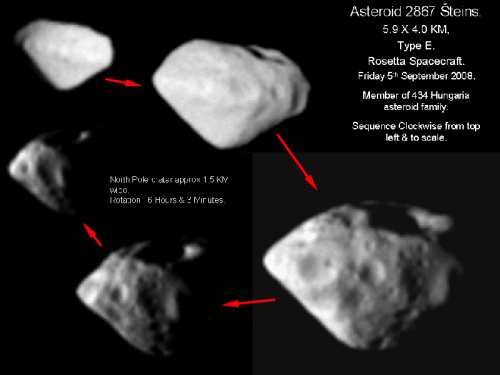
In the "zero-phase" released WAC
image of the sunlit side of 2867 Steins (below, left), not only is
the asteroid's remarkable overall "diamond shape" strikingly
apparent... but, at least four, regularly-spaced "bright flanges"
can also be seen - stretching across Steins visible circumference in
an obvious straight line.

Each "flange"... carefully aligned exactly in the "diamond girdle
plane."
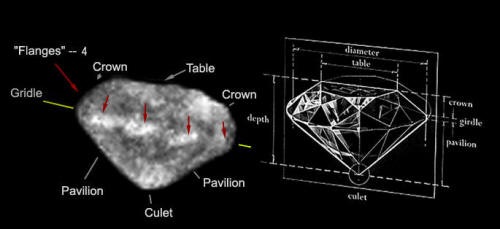
This extraordinary degree of 2867
Steins' "geometric faithfulness" to the basic "diamond cut," coupled
with the placement of these regularly-spaced "protruding flanges"
all along one plane ("the girdle"...)
Compellingly argued for...
"Design!"
It was at this point in our Enterprise Mission/Rosetta investigation
that we got a break.
A few hours after its formal September 6th
press conference, ESA quietly released an animated version of
Rosetta's entire "Steins' approach and recession profile"
(below video) on its
official Rosetta website - composed of a series of actual,
successive Wide-Angle Camera images taken during the Encounter
(below).
An animation of the
closest approach of Rosetta to asteroid Steins,
taken with the OSIRIS imaging system’s Wide Angle
Camera.
The image sequence starts 3 minutes before
closest approach, from a distance of about 2000 km
and ends 4 minutes after closest approach.
At the start of the
animation, the sun illuminated the asteroid from
behind the spacecraft and no shadows are visible on
the its surface.
Later, the sunlight is incident
from the left, and craters and more surface features
become visible.
Credits: ESA
©2008 MPS for OSIRIS Team MPS/UPD/LAM/IAA
/RSSD/INTA/UPM/DASP/IDA
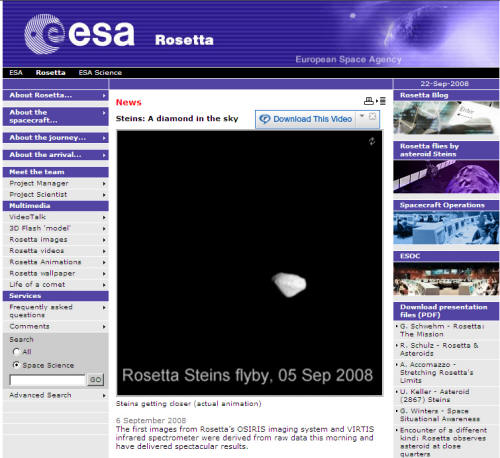
Surprisingly, the images making up this animation turned out to be
of MUCH higher quality than the half-dozen or so "stills" released
at the earlier ESA Steins press conference - allowing further
Enterprise analyses of what Steins "actually might be...."
Then, a few more days following the September 6th Steins press
briefing, members of the Rosetta team quietly released the one and
only published Narrow-Angle Camera view from the Encounter (and, in
color...) - a composite image (red, green and blue) taken about ten
and a half minutes (~3500 miles) before Closest Approach (below, far
left).
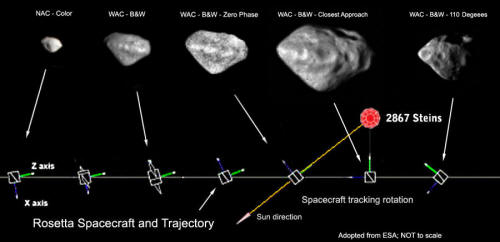
Unfortunately, because Rosetta was still "over a continent away"
from the asteroid when this image was acquired (more than the
distance from Los Angeles to New York!), it is of even lower
resolution than the later, wide-angle shots previously released.
However, despite this lower resolution, the earlier perspective on
the asteroid from this vantage point turns out to be critically
significant:
Because,
This unique view allows us to see about ~ 10-degrees "further to the
west" than any other approaching Rosetta images released so far...
into the previously unseen "western hemisphere" of Steins.
It is
also (because of the overall Rosetta fly-by trajectory) taken
significantly below the "diamond girdle plane" - which allows a
unique "looking up" perspective on the "flanges" - for critical
comparison with the much later WAC images, which (again because of
the encounter geometry) were taken "looking somewhat down"... from
above "the girdle" as the spacecraft receded from the object....
When this most opportune NAC color image is even moderately enlarged
and enhanced (below), it therefore reveals a fascinating amount of
new and critical geometric detail... reinforcing our initial
impression (from the later WAC images) that the "two halves" of
Steins - left and right - in fact, differ radically in their overall
appearance!
The key question (to be answered by further scientific analysis, of
course) is... "why the dramatic difference?"
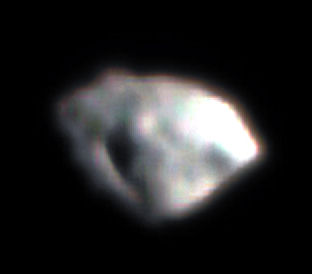
Strikingly apparent in this enhanced NAC image is further evidence
of "the extraordinary symmetry and order" exhibited by the "girdle"
surface features recorded on the later WAC images; a remarkable,
"highly organized" geometry... now confirmed to completely extend
across this previously unseen "western hemisphere" as well....
For example: it is clear, even from this reduced resolution image,
that there are more of those mysterious "raised vertical flanges"
noted previously - still following "the girdle plane" around this
object (comparison below - between two different-processed versions
of the same NAC color image - with the "paired sets of flanges"
noted by the circles).
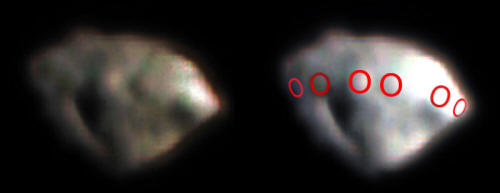
Second, one can also see a marked symmetry (vertically and
horizontally) in the location of the two largest shadows in this
hemisphere (as well as a distinct absence of random "impact
craters"...) - with a marked "curve" to the shadow on the left
(above).
This provides strong indication that this left-hand "curved
shadow" is not, in fact, the shadow of a crater rim... but is
actually caused by an equally-curved "vertical buttress" on the
"diamond's" facing hemisphere - the one directly in front of the
approaching spacecraft camera.
A "buttress" extending downward from
above the "girdle plane," to the "culet" at the "diamond's" tip (see
again the "cut diamond diagram," above).
In fact, judged by the placement and geometry of both these shadows,
and the light areas in-between (determined by the known illumination
angle to the sun - 34 degrees), there appear to be three such
"massive buttresses" visible in this new hemisphere, arrayed neatly
at 60-degree angles--
Left... center... and far right (below).
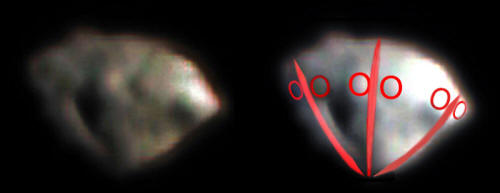
Again, such blatant symmetries are NOT the hallmark of any "natural"
objects... however much the ESA team - totally ignoring their own
extraordinary geometric evidence - tried to sell the idea to the
press that,
"...Steins is just another example of a typical solar
system asteroid."
Perhaps the most mysterious (and potentially revealing) aspect of
this object - 2867 Steins - is this striking hemispherical
asymmetry, seen in a simple comparison of several images taken
before, during, and after Closest Approach (below).
While the
hemisphere turned toward Rosetta as it approached (below - image #1)
is marked by an extremely reflective ("high
albedo") surface... the
right-hand side further to the east (images #2, 3 and 4) present a
much duller... and far more familiar cratered view.
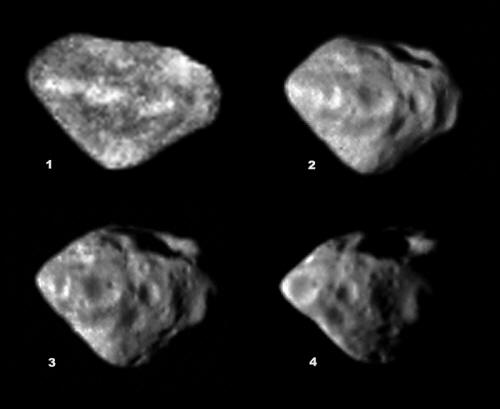
Long before Rosetta got close enough to Steins to resolve it as "an
object," one of the on-board cameras
repeatedly imaged its pinpoint
appearance (below) against the background stars, recording the
resulting "light curve" as Steins rotated every 6.05 hours in front
of the approaching spacecraft.
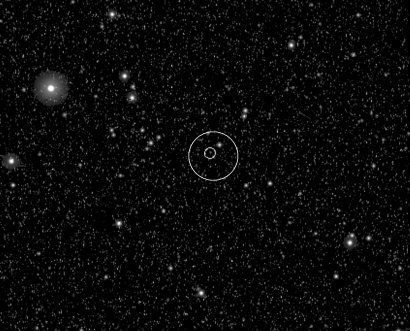
This recorded light curve (below, left), besides nailing down the
rotational period of Steins, was also used to construct a
mathematical model of what the close-up images (to be acquired weeks
later, during the actual fly-by) might look like (below, right).
As
you can see... based just on their computer manipulation of this
light curve - of literally "a rotating point of light" - the
"modelers" turned out to be amazingly correct!
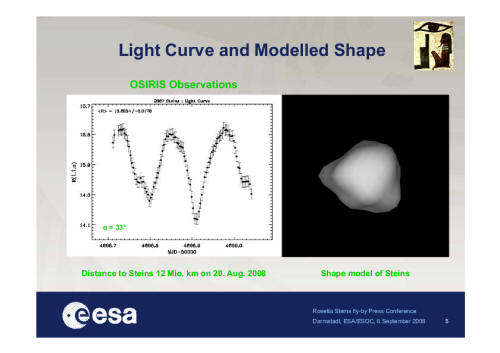
Steins' light curve also plays directly
back into our earlier observation re the images: unequivocally
confirming that one hemisphere of this increasingly remarkable
object is significantly more reflective than the other; the light
curve data (above, left) demonstrates that - as Steins rotates in
space - this quantifiable difference in reflectivity between the two
opposing hemispheres... approaches 50%!
Steins average visual
albedo is 35% - the high end of brightness for
"an asteroid" (the average asteroid albedo range is from 1% to
around 20%). This extreme reflectivity for Steins (and striking
difference in hemispherical reflectivity...) thus provide additional
clues as to what Steins could really be....
An even more dramatic example of this remarkable hemispherical
dichotomy is a comparison between a "reduced brightness view" of the
NAC approaching color image (below, left), and a WAC B&W image of
the opposing hemisphere (below, right) - the latter appropriately
reduced in resolution to match the left-hand image.
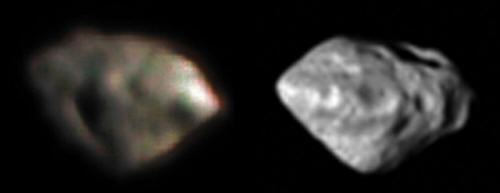
This comparison clearly underscores the fact that, while the bright,
western hemisphere of Steins (above, left) presents a "highly
organized," structural appearance... the far duller eastern
hemisphere (above, right) presents, as previously noted, that much
more familiar cratered view....
Raising again the crucial question: "why this dramatic difference?"
In this comparison (below, left - top and bottom), we have taken two
of the WAC images and traced the "line of dichotomy" between these
two distinctly different hemispheres, as they changed perspective
between the two successive images (below, right - top and bottom).
The surface to the left and below the red line (west and south)
appears distinctly more reflective and far less cratered (even after
we've suppressed most of the intrinsic brightness, to being out the
detail) than the surface to the right and above the red line (east
and north).
The latter presents a seriously battered meteor
appearance... created by many conspicuous impacts, large and small.
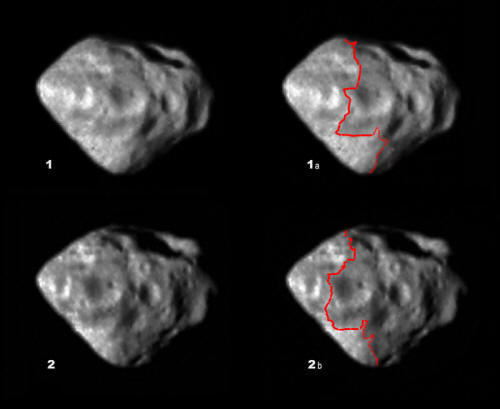
Independent observations of these craters, quoted
in subsequent news
reports, made by members of the Rosetta team itself - re, the
anomalously large number of craters appearing on such a tiny
asteroid - were quite revealing....
"... images beamed from the
spacecraft show the diamond shaped asteroid looming like a
threat from the famous Asteroids computer game before the deeply
pockmarked surface becomes clear. It has provided scientists
with their closest look at an asteroid to date. Huge impact
craters up to 1.2km wide can be seen covering the surface of the
3 mile diameter asteroid in a far higher concentration than
would be expected for such a small object.
"'There is also a chain of seven craters that we would not
expect to see on such a small body,' said Professor Uwe Keller,
a principal investigator at the European Space Agency (ESA),
which is behind the Rosetta mission. 'We normally see craters
like this on moons like our own. We have to look at why they are
there, but clearly Steins has a complex collision history
[emphasis added]...."
The largest crater on Steins' surface - the one completely
dominating the northern "pole" (below, red arrow) - is so large (~1
mile across...), compared to the 3-mile diameter of the Steins
itself that, according to
Space.com,
"[the ESA] scientists were
amazed that the asteroid survived the impact [emphasis added]...."
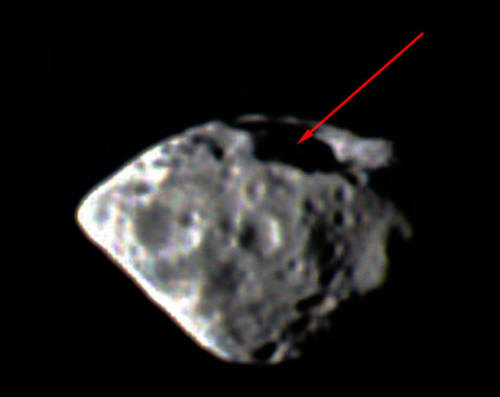
In addition to this major, potentially catastrophic crater (in the
officially-processed ESA image, above), what also can be seen in
this image is the brilliant left/right "dichotomy" discussed
earlier; the striking contrast between the extremely "high-albedo
surface" to the left (the "front" of Steins, as Rosetta
approached...), and the heavily-cratered, much less reflective
surface to the right (in this image), in this processing, is
overwhelmingly apparent....
Such a startling difference in reflectivity between hemispheres
"only 90 degrees apart," again, on such a tiny object, is simply NOT
explicable by any normal "phase-angle scattering effects" typically
used to analyze such solar system objects (a surface changing its
apparent reflection because of a changing observation angle -
between the spacecraft, Stein's surface and the Sun).
For, in this
case, the total angle subtended by this 3-mile-wide asteroid, as
seen from the Rosetta spacecraft, was essentially unchanging in this
view... only about 2 degrees, "at the max"--
Across such a minor angle, there should be NO such dramatic "phase
effects" - at all!
Yet, in Stein's case - mysteriously - there obviously is....
The only reasonable explanation for this otherwise baffling
reflection phenomenon must lie in some kind of fundamental
"compositional difference..."; the hemisphere of Steins that (by
fortunate circumstance...) was facing the Rosetta spacecraft as it
approached - with the Sun directly behind the camera (the so-called
"zero-phase perspective" - below, left) - is somehow dramatically
different from the surface further around to the east... recorded as
the spacecraft viewed this tiny object a few minutes later from a
position some 90 degrees to its approaching view (below, right).
It is this composition difference which, somehow, must be
responsible for not only in the remarkable change in surface
brightness as one moves further east... but for the simultaneous
presence of all those impact craters on that same (somehow, much
less reflective) surface....
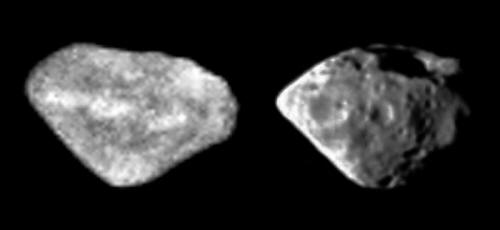
If one looks closely at one of the best Rosetta images taken during
Closest Approach (below, left), one can actually see several
"layers" (below, right) to that surface... on the eastern side of
Steins; these successive layerings (marked in red, green and
blue...) appear to descend - from "higher" levels in the west
(toward the left) to "lower" levels in the east (to the right)... as
one moves further around the object toward the shadow line.
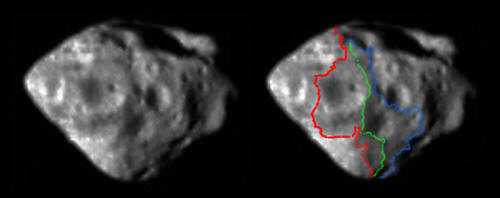
So, what could that be all about?
The simplest model for all this - the one that best explains all
these remarkable observations - is that "Steins" is, indeed, an
artificial object... that has suffered, as Rosetta scientist Uwe
Keller termed it, "a complex collision[al] history."
This Enterprise "artificial" model predicts that, because of those
collisions, one entire half of this small celestial body has
suffered massive stripping of a former, highly reflective "outer
casing" or "outer hull"--
A "casing" which is still (more or less...) intact across one
hemisphere - the side that Rosetta captured with its one distant NAC
image before the fly-by (below, left) - but is now heavily cratered
and abraded in the hemisphere the spacecraft imaged with its WAC
Camera at Closest Approach and after (below, right)!
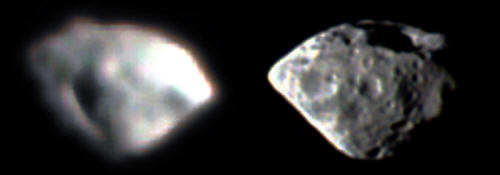
This model neatly and comprehensively accounts for the smashed and
battered appearance of this eastern hemisphere... which is, in fact,
comprised of the same underlying structural components (now,
all-but-obliterated - below, right) as those seen on Steins'
opposing western hemisphere, during the approach (above, left).
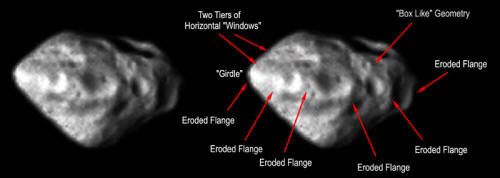
What is also apparent, because of the much higher resolution images
taken of this eastern hemisphere, is the striking appearance of
several additional geometric features on this fascinating object -
most notably, what appear to be enormous, distinctly separated
"windows" (yes, windows...) - aligned horizontally, in two parallel
rows, just above Steins' highly reflective "girdle" (above, right).
These amazing, familiar-looking artificial features are then joined
(further to the east...) by an even more compelling detail - what
appear to be exposed "structural components" (resembling a giant
"box-like structure"... ), located above the "gridle" - at the top
of one of those massive "buttresses" seen on Stein's preceeding
hemisphere.
If this is what this feature really represents - an exposed, major
structural element of "Steins" - it has likely been stripped of its
protective covering and exposed by more of the same major impact
damage seen all across this hemisphere.
This same type of damage has
apparently removed almost all the rest of Stein's brilliantly
reflective covering in this entire hemisphere, except for western
sections of "the girdle" (below, left)... and some additional
regions around the pointed "culet" at the base of Stein's basic
diamond shape.
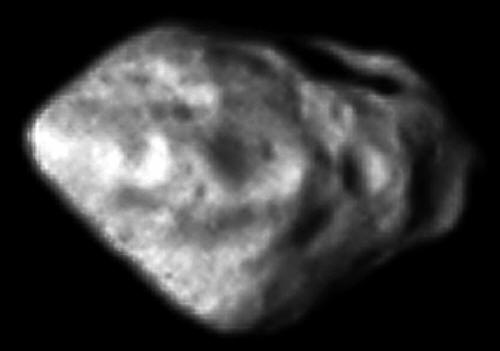
Careful examination of this remarkable image also reveals a myriad
of additional geometric features that - taken all together - form
compelling testimony as to the potential true nature of this
extraordinary object.
So, let's summarize the major conclusion of our month-long
Enterprise analysis of "2867 Steins":
Based on a variety of evidence, including the preliminary results of
the Rosetta spacecraft's fly-by... it is increasingly unlikely that
Steins is, in fact, a "natural" solar system object!
If this hypothesis is correct (a Big "If"...), then Steins is also
certainly NOT "made of rock" (as astronomers have been assuming...),
but is, in fact, a 3-mile-wide manufactured artifact - currently of
unknown surface composition - about the size of a small "town."
It is something
WE could build in "zero-G," even given the
antiquated technology of NASA... if we had the funds.
Based on telescopic visual and IR spectral data gathered from Earth
prior to Rosetta's fly-by, Stein's external composition could, in
fact, actually be some form of "refined metal"; this is based, in
part, on its unique spectrum - classified as "E"
according to
planetary catalogues - making Steins among the rarest of all
asteroid types... a spectral classification shared by only about
30
other objects in the entire solar system (as evidenced by this
comparative spectral graph - below) - out of over three hundred
thousand asteroids known!
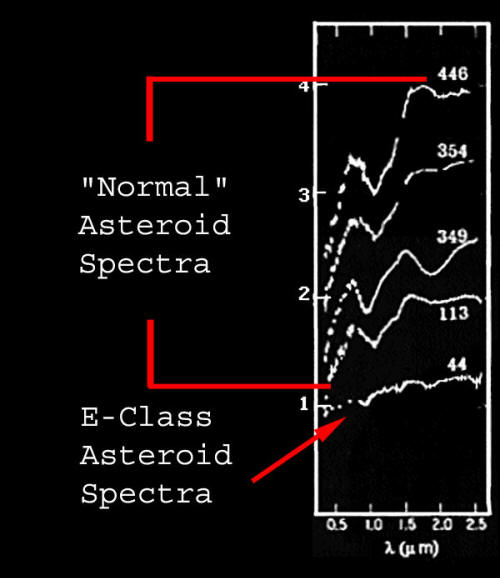
Steins' rare "E-type classification" was reinforced by some (still
unpublished...) Rosetta close-up spectral observations from the
fly-by, "snuck in" to the Spectember 6th ESA morning press
conference by Principal Investigator for the Visible and Infrared
Thermal Imaging Spectrometer (VIRTIS), Angioletta Coradini,
commenting,
"We didn't expect to present data today. But we got part
of the data and they are really exciting...."
Thus Coradini
was able
to give a quick "sneak preview" of a couple of the VIRTIS spectral
graphs of Steins (below) - clearly (with a much higher
"signal-to-noise ratio") supporting the uniquely "flat spectum" of
these fascinating objects.
(A more complete explanation of what Rosetta discovered - in terms
of Steins' key surface composition - is awaiting peer-reviewed
scientific publication of the VIRTIS data....)

"E-class" asteroids, historically, have also shown unique
responses
to
reflected radar signals.
"... the most unusual feature of
these observations is that all exhibit very high polarization
ratios, u = 0.8... Values larger than zero are caused by
wavelength-scale near-surface roughness and inhomogeneities
and/or subsurface or multiple scattering [emphasis added]...."
Translation:
According to these recently published Arecibo radar observations -
specifically of two medium-size E-class asteroids, "44 Nysa" and
"434 Hungaria" - some of the radio waves reflected back to Earth
(remember, from asteroids spectrally identical to "2867 Steins"...)
could actually be coming, not from their surfaces... but from
multiple reflections deep inside!
According to these "highly polarized" radar observations, the two
E-type objects are also about 20 percent more efficient at
reflecting radar signals overall... compared to any other type of
asteroid!
These combined observations are thus totally consistent with E-type
asteroids being a) covered with some type of highly efficient,
electrically conductive "casing" and b) also being, essentially...
Hollow!
In other words, the data suggest that some of the radar echos are
literally returning from deep within - "scattered" multiple times
(thus, polarized...) by countless reflections between the flat,
geometrically-spaced walls of innumerable interior corridors and
rooms!
Based on the preceding Earth-based visual and radar observations of
these E-class objects - combined with Rosetta's history-making
fly-by of the first example seen in close proximity - Steins could,
indeed, now be the best-known representative of a totally new class
of solar system "object"...
One of only a few dozen "E-type" ancient space platforms... still
orbiting the Sun....
Which bring us to the "speculative" (and therefore, fun!) part of
this analysis.
Obviously, all the images and data we've presented here on the
Steins fly-by can easily be verified, by referring directly to the
appropriate ESA Rosetta websites. The correlative ground-based
scientific data (Steins' spectral classification as an "E-type"
object... the remarkable Earth-based radar observations of similar
E-class "asteroids," etc., etc.) can be read at the various links
included, above.
The proper scientific interpretations of these data, however, are a
bit more difficult....
Declaring any solar system object (as we also did with Iapetus...)
convincingly "artificial," is immediately fraught with complications
- from the quality (and quantity) of scientific data made available
"by the authorities" on which to make such an assessment, to the
political and psychological climate extant at the time when such a
hypothesis is ventured... especially the "political."
In terms of Steins, it should now be obvious (to any objective
observer...) that it is anything but... "asteroid-like."
Its extraordinarily specific topological symmetry (a "diamond"),
coupled with its remarkable, repeating geometry reinforcing that
perception (regularly-spaced vertical protrusions in its surface,
but only in the 'diamond girdle' plane... the "buttresses"... and
remnants of complex, surface structural remains....), all argue
compellingly for Steins as artificial. The "asteroid's" marked
overall asymmetry (in terms of the light unevenly reflected by the
two opposing hemispheres...) - on an object otherwise remarkably...
anonymously... symmetric - completes the "artificial" picture....
Yet, even venturing such a "hypothesis" - without significantly
better resolution imaging evidence in hand - is guaranteed to bring
about a rain of diatribes against the individual proposing such a
"model"....
This is why, amid the self-congratulations going on around the
Rosetta Mission throughout that first post-fly-by Saturday morning
press briefing, as soon as I heard the words "the highest-resolution
NAC Steins images have been LOST... nine minutes before Closest
Approach..."...
I KNEW that Steins had to hold critical proof re the "ancient,
inhabited solar system" model--
Which is why "they" were deliberately suppressing those key images!
The nature and timing of the bizarre "camera failure" announcement -
not until some "forty minutes into the 'morning after' press
briefing," and then casually blamed on "a software 'safing'
error" - made me instantly wonder what the Rosetta team had SEEN on
those 5X higher resolution images at Closest Approach... and
COULDN'T tell us?
Which had forced them to invent such an obvious "bold-faced lie" to
cover up the fact that startling NAC close-ups of Steins were
already on the ground?!
Note that in the official release it is specifically cited that the
Narrow-Angle Camera went into "safe mode" (meaning, it curled up
electronically into the equivalent of a fetal ball...) at nine
minutes before the minimum distance from Steins. And that the images
taken just before cut-off would NOT be any better than the BEST
images taken by the wide-angle camera AT Closest Approach!
"Coincidence?"
I immediately thought NOT... as did one of our "intel sources" when
I asked.
Having teased every last pixel of detail out of the Rosetta/Steins
WAC animation images (below), I find it very difficult to believe
that the NAC randomly cut out JUST before we could get any imaging
data BETTER than the best detail we've been able to extract from the
WAC data... no matter how "plausible" the technical excuses
sound....
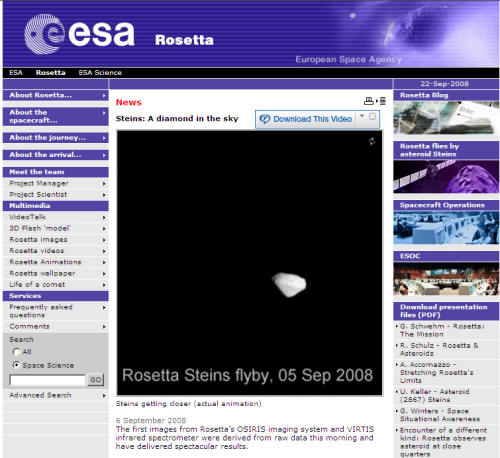
Because, if we had that even slightly better imaging data... there
would be NO QUESTION now in any observers' minds regarding the
overwhelmingly artificial nature of "2867 Steins!"; the organized
"structural geometry" present all over its surface would almost
"leap off the screen."
Geometry that "someone" carefully arranged that we would never get
to see... because "the camera failed..." nine minutes short of the
goal line...
As one of the political candidates said the other night during the
debate:
"And, if you believe THAT one... I've got 'a bridge to nowhere' I'll
gladly sell you - real cheap!
So, extrapolating from the boarder-line "smoking gun" imaging data
we do have
Oddly enough, the dramatic
"hemispherical asymmetry" of Steins turns out to be THE overwhelming
clue to all these questions...
To, in fact, an object in surprising accordance with ancient solar
system events described with great specificity in our 2001 "Mars
Tidal Model" paper, as well as in our later (2005) Enterprise series
on Saturn's most mysterious moon, Iapetus - "Moon with a View."
In both these major Enterprise investigations, our efforts at a
realistic "reconstruction of an ancient solar system chronology..."
(in parallel with Tom Van Flanderns' independent efforts in that
same direction - see below) has been overwhelmingly supported by
later NASA and ESA official revelations from their on-going Mars
missions - most notably, in the continuing "ancient Mars'
oceans/current ice/water" saga...."
One of the major predictions of the "exploded planet hypothesis"
(EPH), is that "normal" solar system events came to an abrupt and
catastrophic crescendo ~65 million years ago - with the sudden,
literal explosion of one of the Sun's major inner planets... the one
NOT orbiting where the current asteroid belt now lives!
The visible scarring and other effects of such an inconceivable
catastrophe on other bodies in the solar system were
discussed by
Tom Van Flandern many years ago:
"... a major [planetary] explosion
would send a blast wave through the solar system, blackening
[and cratering] exposed, airless surfaces in its path. Most such
solar system surfaces are indeed blackened [and heavily
cratered], even for icy satellites. But a few cases have such
slow rotation that only a little over half of the moon gets
blackened. Saturn’s moon Iapetus is one such case, because its
rotation period is nearly 80 days long.... One side is icy
bright; the other is coal black. The difference in albedo is a
factor of five....
"Perhaps the most basic explosion indicator is that all
fragments of significant mass will trap smaller nearby debris
from the explosion into satellite orbits. So explosions tend to
form [systems of] asteroids and comets with multiple nuclei of
all sizes. Collisions, by contrast, normally cannot produce
fragments in orbits because any debris orbits must lead either
to escape or to re-collision with the surface.
Moreover,
collisions tend to cause existing satellites to escape, leading
to asteroid “families” (many of which are seen). Our prediction
that asteroids and comets would often be found to have
satellites has been confirmed in recent years. The first
spacecraft finding (by Galileo) was of moon Dactyl orbiting
asteroid Ida in 1993. More recently, Hubble imagery found that
Comet Hale-Bopp has at least one, and possibly three or more,
secondary nuclei.
"Over 100 additional lines of evidence related to the eph and
the standard models it would replace are summarized [at
Meta
Research]...."
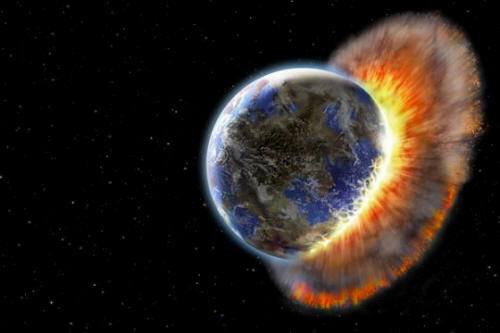
Tom's extrapolation re the physically effects of "an ancient
solar-system-wide catastrophe..." on satellites in the outer solar
system, could easily be applied to other solar system objects as
well... some located much closer to "ground zero!"
Like "2867 Steins."
It works like this:
If Steins - as a functioning space platform (in our model) - had
been orbiting too close to Planet V when the latter blew up (within
"a few million miles...") Steins simply would not have survived; too
far away, and the outward rushing debris cloud would have had too
low a density to leave the kind of visible "high concentration"
damage that we see in the WAC images.
The latter is because the debris-front
of the expanding planetary cloud (when it reached Stains...) had to
have still been a relatively thin, high-density "shell" (moving at
several miles per second...), but not too dense (or Steins would
have been destroyed)... and... passing Steins relatively quickly...
Otherwise... all sides of Steins (remember, rotating every ~6
hours...) would have been heavily damaged by the impacting debris.
In stead, only one side of this diamond-shaped object was
(apparently) affected...
While the opposite side (judging from the single NAC image that we
have, and Rosetta's light curve...) was left almost completely
intact!
From which, we are able to reconstruct the following, probable
"sequence of events"....
Subjected to a relatively brief (but intense) rain of "planetary
crustal fragments" from the horrific explosion of the distant
Planet
V, combined with the effects of an expanding micrometeorite cloud of
condensed planetary mantle rock - all rushing past at several miles
per second.
Steins had its highly reflective "casing" completely
scoured off one half of its exterior (the side facing the
explosion...), immediately followed by the larger, solid fragments
impacting directly that same side... with visibly catastrophic
results (below)...
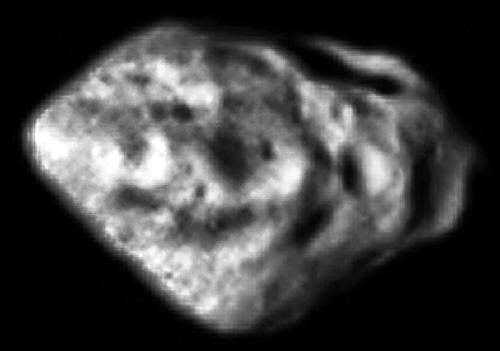
Leaving the unmistakable signature of a LOT of
highly destructive
impacts... but only on ONE HALF of Steins,
"... in a far higher concentration
than would be expected for such a small object...."
That latter, critical observation CANNOT be explained by any
"steady-state" model of impacting debris... spread across the
lifetime of the solar system!
It can ONLY be satisfied if Steins was, indeed, exposed to,
"a
sudden, short-duration rain of high-speed blast-wave-objects
(below)... causing out-of-proportion destructive impacts from the
distant, cataclysmic destruction of an entire planet!"
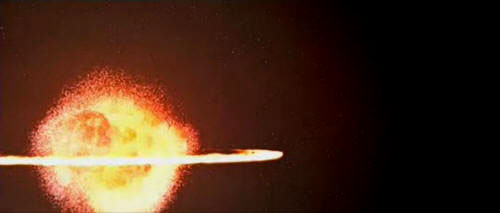
Thus, the EPH model - immediately and easily - can account for two
major puzzles stemming from Steins' close-in imaging observations...
observations that are left completely unanswered by all the
prevailing asteroid models....
So, what else could it explain...?
How about this little mystery... also voiced that Saturday morning,
by Rosetta camera principal investigator, H. Uwe Keller:
"...you also see a chain of craters
[on Steins], about seven craters in a line. Those are a
phenomenon we observe on the Moon; [there] they are either
produced by a multiple impact or by ejecta [from one impact]. On
a small body like this we really have to think about what the
explanation of this is [emphasis added]..."
Here (below) is what Keller was referring to:
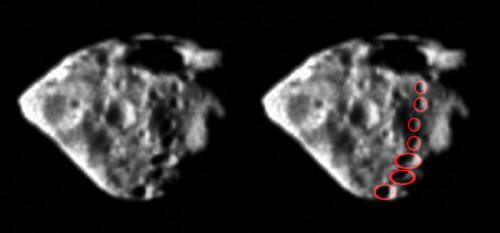
His polite "...we really have to think about what the
explanation of this is..." was just another way of saying:
"We haven't a CLUE to what's really
going on here!"
So, while the "mainstream" asteroid
model cannot seem to figure out how to produce, not only the heavy
concentration of impact craters seen on Steins' eastern hemisphere,
but an additional "impact crater chain"--
Again, the EPH model easily can.
The mysterious "Steins' crater chain" (according to the EPH) is
simply the subsequent collision of Steins with one of those
"multiply-bound asteroid systems" that Van Flandern predicted also
HAD to form... if a planet can really destroy itself in "an
explosion."
Such multiple, gravitationally-bound systems would have been
inevitably fostered by "whirling debris... orbiting around other
whirling debris..." all created in the turbulence of the expanding
debris cloud from that explosion... a sequence of inevitable events
caused by the fragmentation, pulverization and subsequent ejection
into space of an entire planetary crust!
Again, quoting Van Flandern:
"... the most basic explosion
indicator [from the EPH Model] is that all fragments of
significant mass will trap smaller nearby debris from the
explosion into satellite orbits [around the larger fragments -
emphasis added]...."
Thus, in the context of the EPH model,
it is obvious from the close-up images of Steins that this type of
"multi-body, orbiting system collision..." is the most likely source
of this, otherwise "inexplicable" line of craters stitched up
Steins' entire eastern flank.
Providing further confirmation of this model, is the fact that these
"multiple impacts" also occurred, significantly, directly opposite
the far less-damaged "Rosetta approach hemisphere"... as if they
also were coming directly from the source of "an explosion"...
behind Steins...
Again, all in exact accordance with the Exploding Planet Hypothesis.
Leaving us with remarkable new evidence - "2867 Steins" itself! -
for the previously determined existence (from other evidence...) of
"a ~ 65-million-year-old, ancient, solar system civilization...
which, for some reason, needed to build three-mile-wide, space
platforms - one of which, was shaped like a perfectly cut diamond in
the sky... and was then almost destroyed.
Which, of course, brings up the fascinating question:
"WHY a... 'diamond-cut'...
geometry?"
In the ESA (and every other mainstream)
model for the formation of 2867 Steins, it is assumed that this
object - like the literally hundreds of thousands of other asteroids
now catalogued - is simply, literally "a chip off the old block."
That, through incessant collisions... over billions of years...
newly-formed "rocks" like Steins, left over from the forming solar
system, would have been inexorably shaped ("ground down"...) by
relentless external impacts... into their current configurations.
In this model, Steins' "impossibly precise" diamond-cut geometry is,
if course, seen as purely accidental... the simple "interesting"
result of those innumerably random interplanetary collisions.
For this reason, any data supporting the current Enterprise
hypothesis - that Steins was, in fact, deliberately, intelligently
manufactured... and, as a carefully-planned 'diamond in the sky',
"could be decisive... in terms of deciding if Steins is, in fact, a
bona fide "artificial construct"....
Well, we have found that data.
Just as we proposed that the geometric shape of Iapetus was "by
design"... and a major clue to its ultimate end use... as a
radar-stealthy "moon"...
So, we have reached similar technical conclusions regarding "2867
Steins."
That, all other attributes aside, one of its key geometric functions
seems to have been deliberately designed to interact with radar...
in a highly specific fashion--
TO BE DETECTED!
In other words, every aspect of Steins' geometry - from the
technical radar-return perspective - seems to be the exact opposite
of the geometry of Iapetus; while Iapetus' geometry was apparently
designed to "hide"... Steins geometry cannot help but shout out to
any active radar system:
"HERE I AM!"
Which - when put together with WHERE
Steins
was discovered orbiting (10 degrees above, but within, the
Main Belt Asteroids...), and how close this is to the proposed
orbital location of the original "exploding Planet V"... leads directly to Steins' potential PURPOSE.
As a "city-sized" rescue craft... from the same ancient solar system
catastrophe we've been discussing!
If you look even casually at Steins' remarkably faithful
"diamond-cut" geometry (below, left), and compare it with the
classic reasons for that specific cut (below, right), you reach a
very interesting conclusion:
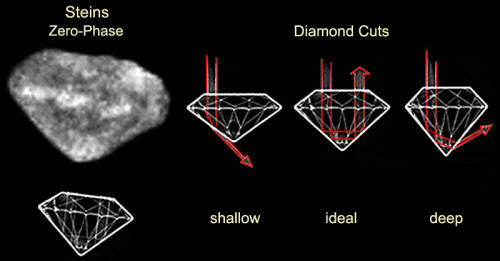
Diamonds are cut the way they are for one essential reason:
To
interact "brilliantly" with light.
If we replace these classic "lightwave" reflections and
refractions (above, right center) with microwaves, the geometric
"diamond principle" still applies... if the interior and exterior
manufacturing geometry also remains the same...
And, if the material used in this construction interacts with these
radar wavelengths in the same fashion as "light" does (within the
crystalline geometry of a real diamond...).
The overall effect will then also be precisely "diamond-like."
Thus creating an "artificial, miles-wide diamond in the sky" - which
would literally "sparkle" (on a radar screen) with the
reflected/refracted microwave energy being beamed at it... just as a
real diamond does when hit by light (below)!
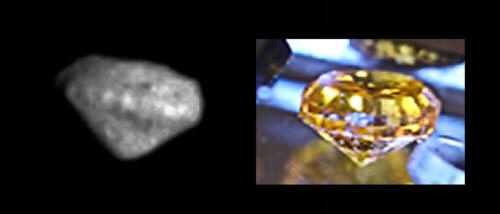
(Which, of course, returns us to those "highly anomalous radar
signatures" of ALL the E-class asteroids currently investigated;
what would radar observations specifically of "2867 Steins" now
reveal...?!)
This, of course, is exactly the type of "passive beacon" property
you'd want to build into any space fleet of "rescue platforms"
(designed to house literally millions of refugees from a dying
planet)... platforms that you would desperately needed a foolproof
system to relocate, anywhere in the solar system... after the
catastrophe!
As can be seen in our example (above, right center), from one angle,
the proper "diamond cut" - regardless of the specific material - has
the unique property of reflecting the incoming energy (be it light
or microwaves... ) directly back along the incident path... a
property called "retroreflection."
This technique was used very
effectively by the Apollo Project, in designing the arrays of
optical, diamond-shaped prisms (below, right) the astronauts carried
to the Moon for the "Moonbounce laser experiments" that has
continued to take place over the last several decades, after they
departed....
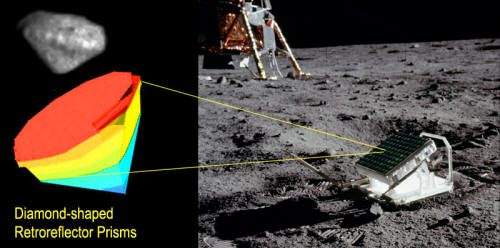
Such a "retroreflection" principle, if deliberately embodied in the
design of the diamond-shaped "space platform," such as Steins... is
the one parameter that would have insured its quick location (if it
survived...) - regardless of its damaged condition or orbit... after
the Planet V explosion....
This scenario also answers several additional questions raised by
Rosetta's Steins' Encounter, including the major one:
"Why is it still there?"
As previously noted, among the two dozen
or so craters initially identified... heavily concentrated in this
eastern hemisphere, Rosetta discovered one real "monster" - covering
the entire northern rotational pole... and almost a mile wide - on
an object only about three times wider than the crater itself
(below)!
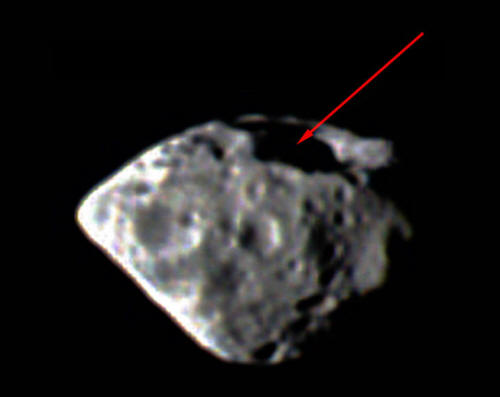
As soon as everyone saw that massive impact scar, the question that
immediately came to mind (including, among the ESA scientists
themselves...) was:
"Why didn't that disproportionate
collision... totally destroy this tiny object!?"
Again, the "space platform" hypothesis
has a ready, elegant answer.... If Steins is NOT a "normal"
asteroid... if it is really a "city-sized, space platform" - with a
geometry specifically built-in to return "microwave scanning beams"
(radar...) directly to their sources..., then, this yawning "polar crater" suddenly takes on a totally
different character....
That, despite its misleading appearance, it's NOT just another
"impact crater"... but a specific, integral part of Steins'
carefully designed, geometrically precise "diamond structure"...
A carefully tailored opening (now, of course, badly eroded by
megayears of micrometeorite abrasion...), originally designed to
allow microwaves to penetrate deeply... directly... into Steins'
interior (below) - so those same microwaves would then be reflected
directly back to the radar stations searching for Stein's
location... after the explosion of Planet V!
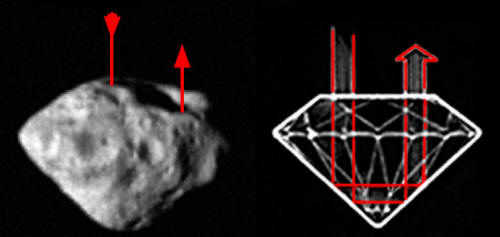
If this analysis is accurate (thus, requiring no "asteroid
shattering" impact at all...), it immediately prompts reexamination
of all the other "craters" on Steins' surface - so many that, even
the official ESA analysis
noted their curious abundance "...in a
far higher concentration than would be expected for such a small
object...."
If we look at Steins' from the perspective of a "man-made" object
(in the broadest understanding of that term...), and NOT "just
another asteroid" - our perception of its images... and the size,
nature and distribution of these other surface "craters"... really
shifts...
And we begin to see another, otherwise completely overlooked
geometric pattern!
Which neatly "lines up" craters that are not only "all about the
same size... and regularly-spaced"... but, suspiciously all in the
same plane as Stein's remarkable "diamond girdle" feature (below).
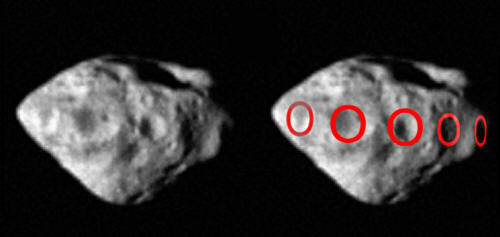
From this obviously non-random distribution, one can cautiously
speculate that these "aligned girdle craters" in this eastern
hemisphere are, in fact, the shattered remains of those remarkable
"protruding flanges" seen on the other side of Steins!
Only, in this
hemisphere, they've now been smashed and almost totally destroyed...
with only their surrounding structural framework and connection to
the massive "North/South buttresses" still partially surviving....
As to to their original functions, that could be anything:
"Cavernous airlocks"... "spacecraft
docking bays"... "fuel storage tanks"... anything... requiring
"a large, enclosed volume... in the 'girdle plane'"
"Volumes" that are now totally,
catastrophically exposed to space... but that have preserved, even
in deaths, their tell-tale geometric spacing....
It should be crystal clear by now that I don't believe for a
nanosecond the ESA "party line"... that the Narrow-Angle Camera
"suddenly went into safe mode... all by itself..." just before
Encounter; I mean, how convenient....
But, it gets worse.
Based on the preceding evidence, it is my growing suspicion that
"2867 Steins" may not have been a "random target of opportunity"
after all - but was, in fact, a clandestine Prime Objective of the
Rosetta Mission... from the beginning!
If this analysis is true, then Rosetta's
whole "delayed departure
story" - and its back-up choice of an entirely different comet to
its original primary objective ("Comet Wirtanen") could have
been part of an elaborate, clandestine different mission all
along... to successfully fly-by Steins... and confirm, first-hand, the remarkable suspicions about Steins
which ESA (somehow...) already had in its possession!
But, how would THAT be possible?
For almost a decade, Enterprise has been researching not only the
technical cover-ups of imaging and other planetary data at NASA
pertaining to "an ancient, solar-system-wide, extraterrestrial
civilization...", but the completely unexpected social and cultural
environment surrounding this most elusive topic.
Over the years here
at Enterprise we have presented increasingly robust evidence
supporting the idea that (for some arcane, ritual reasons...) inside
NASA, secret "Masonic rituals" are embodied in essentially every
NASA launch... NASA planetary fly-by... or NASA mission landing....
Our latest, in-depth presentation of the latest evidence is
available in our New York Times bestseller (with Mike Bara): "Dark Mission
- The Secret History of
NASA."
Bottom line:
NASA (and every other global space program... including ESA...
we have come to slowly realize) appears now to not only have a
definite hidden agenda "... to locate and secretly
investigate ancient, extraterrestrial ruins in the solar
system...", driven by some kind of bizarre "ritual plan" -
they have standing orders to conceal this Prime Objective
(and how they carry it out...) with a "plausible, scientific
cover-mission."
The latter, of course, is designed
primarily to keep their respective taxpayers (and even most
scientists involved...) completely in the dark about the real
reasons for these "competing" interplanetary missions'
(increasingly being conducted by... the Chinese... the
Japanese... the Russians... the Indians... the Europeans...)...
and their true objectives.
So, how would ESA have KNOWN that Steins was "an object of
interest"... BEFORE it did the fly-by?
There are two rational answers to this crucial question:
-
Either ESA combined all the existing Earth-based scientific data on
the "E-class" asteroids previously discussed - spectral
observations, photometry, radar... - and did realize (as stated...)
that Steins, as a representative of this unique asteroid type, was
fortuitously "on the way" to an eventual secondary comet target
(Comet 67P/Churyumov-Gerasimenko), in 2014... as advertised.
In other words, they got INCREDIBLY lucky....
-
Or..., the ESA designers of the complete 10-year Rosetta Mission Plan had
access to "secret documents" (from sources "in the know..."),
regarding the true, artificial nature of "2867 Steins" - and thus
based their entire 10-year "secret mission" on the early rendezvous
with Steins... with the much-publicized "later comet rendezvous"
actually being just the "cover story"....
Strong words.
It would be far easier NOT to suspect all of this at this point...
were it not for the fact that the mission's overall, official name
is directly taken from NASA's own covert ritual "Masonic Playbook!"
Rosetta!
For those needing a bit of a refresher vis a vis "Rosetta," here's a
reference from
one of the ESA mission news reports, back in 2004:
"...Rosetta takes its name from the
Rosetta Stone [below], which gave archaeologists the tools to
decipher Egyptian hieroglyphics. Project scientists hope their
orbiter-lander mission is the astronomical equivalent of its
namesake, giving astronomers the tools they need to decipher the
nature of comets [emphasis added]...."

Totally in keeping with this "Egyptian
motif," ESA then went even further... naming the key camera system
aboard its planned comet-chasing spacecraft, "OSIRIS" (below)...
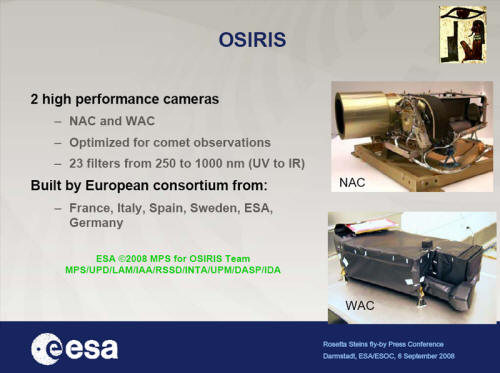
With a logo on every officially released Steins "OSIRIS image" -
literally spelling out (in Ancient Egyptian!) the name of this most
important of Egyptian "gods" (below, upper right corner)....
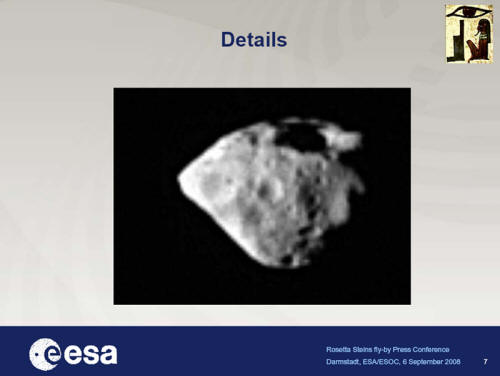
Here (below, left) is a magnified version of that official OSIRIS
logo - side-by-side (below, right) with its Egyptian hieroglyphic
translation....

So, why is "Osiris" important to any "potentially secret Rosetta
Mission to 'an ancient space platform'...?"
Here's how Mike and I described just one example of NASA's
documentable obsession with "Osiris"... in Dark Mission:
"... Orion [Osiris] was... the only
[Apollo 16] Lunar Module in the entire Apollo Program which was
not deliberately crashed back into the Moon after the astronauts
had left the Moon, returned to the Command Module and were
safely on their way home."
"Obviously - because this Lunar Module was the literal 'stellar
embodiment' of the sacred Egyptian god of the Dead and
Resurrection... Osiris...."
"...of the Dead and Resurrection...."
For a Mission whose secret objective (if
we're right...) was "to fly-by one of the long-dead, ancient solar
system's surviving artificial space platforms..." - and thereby
resurrect its memory - the naming choice was perfect....
Further, in looking at the released OSIRIS frames, particularly the
one NAC color view taken about ten and a half minutes before Closest
Approach, I also couldn't help but notice a striking resemblance to
another Egyptian "god"--
Horus!
Look at this side-by side-comparison (below), and see if you don't
notice an eerie parallel yourself....
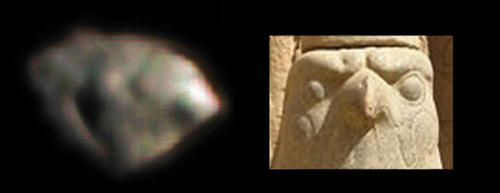
"Horus," in Egyptian mythology, is represented by a falcon... a bird
of prey....
Scholar
Alan Alford has written several books (below) exploring
potential links between such "ancient Egyptian and Sumerian
mythologies"... and the potential cultural effects of a bona fide
"ancient solar-system-wide cataclysm, resulting from the physical
explosion of an entire planet...."
He even terms this his "exploded planet cult theory":
"...it is impossible to say whether
knowledge of these 'exploded planet cults' has survived to the
21st century, but there is plentiful evidence of an esoteric
belief system flowing down through secret societies during the
last two thousand years. Many of the themes picked up in my book
are, for example, evident in certain Renaissance paintings,
causing me to suspect that certain artists were initiated into
exactly the same secrets which I am now sharing in my book...."

Based on the results of our completely
independent research, I would say Alford's "exploded planet cult...
" is quite alive and well... and, among other places, living "high
off the taxpayers" both in NASA and in ESA....
Looking at this remarkable Rosetta comparison (above), one is
definitely struck by the eerie resemblance between,
"the inanimate
architecture of an ancient, massive platform... flying through
space..." and the features of a living symbol... "a falcon metaphor
for a far more ancient inanimate form... known formally as 'the
distant one'... flying through the skies of Ancient Egypt...."
That such a mythological overlay is more than "coincidental," is the
thesis of much of Alford's work: which is, that the ancient
mythological images and "textual codes" underlying all
Egyptian
Civilization (such as those attached to "Horus"... ) and
the
Sumerian's equally striking,
"sky imagery," are actually metaphorical
"explanations of potentially real, incredibly ancient personages
and events... from that long-lost period of pre and post cataclysm
solar-system history...."
And Horus was, of course, the son of OSIRIS.
What better that "an OSIRIS camera"... to take "his" close-up
imagery now...?
If Ancient Egypt was the "metaphorical map" of people and events
from an even more "unimaginable time..." - endlessly relived and
replayed in the mythology of much more "recent" ancient
civilizations here on Earth - this could well answer our key
question:
How did ESA KNOW before they sent the mission... that Steins was, in
actuality, an artificial platform!?
Answer:
Because of the current existence of Alford's "exploded planet
cult..." which (again, somehow...) provided ESA with access to far
more ancient (and far less "ambiguous"...) solar system
information... perhaps in the form of carefully preserved texts... even actual
images (!)....
Whatever form this information took, it apparently (judging by the
results) faithfully recorded snippets of real "ancient solar system
events..." and even incredibly useful navigation data, such as
possibly... exact ephemeredes (locations...) of some surviving
ancient spacecraft orbiting the Sun... masquerading as "mere
asteroids" even now....
If any of this speculation is true... it could finally, neatly,
explain the otherwise "almost impossible-to-understand" overall
Rosetta Mission Plan... the "extended, tortuous course" that ESA
(claimed it) was forced to send Rosetta on... just to reach "its"
back-up comet,
Comet 67P/Churyumov- Gerasimenko.
In truth, because Steins currently orbits "ten degrees above the
solar system plane...", any clandestine mission would HAVE HAD to
involve such a critical set of complex maneuvers after leaving
Earth... all to effect THAT crucial, unavoidable "plane change" to
reach Steins' orbit.
And, "plane changes" in interplanetary travel are EXTREMELY
expensive - in terms of fuel.
So, if Steins was the Primary Mission all along, then the selection
of a second comet, ALSO orbiting well above the solar system
plane, was ESSENTIAL to the cover story... with one big loophole...
If an "alternate comet" was needed as a target (after "Comet Wirtanen" had been originally selected and then scrapped, forced by
the delay)... why did ESA choose another comet ALSO in "a highly
inclined orbit?" Every extra day spent on the ground, after being
fabricated, was an extra day on which some onboard random electronic
system could literally break down (fail...) - resulting potentially
in a later mission loss!
So, why add EXTRA, "risky" time (~11 years...) - hundreds of millions of
extra miles traveling through space, looping past planets... once...
twice... three times! - all, just to rendezvous with another
"highly-inclined comet" (Wirtanen has an inclination of almost 12
degrees...)?, when much more accessible comets orbit much closer to the central solar
system plane...?!
Instead of eleven years... such an alternative "in plane" comet
rendezvous could have been achieved in just a couple years....
So, why add the highly risky "extra time"...?
Unless you HAD to..., in order, in a MOST undercover way... to fly-by Steins!
The idea that somewhere in Europe... or in Washington... there exist
mind-blowing photographic blow-ups of Steins from Rosetta's
fully-operational Narrow-Angle Camera, photographs five times closer
than the ones we have now... photographs that show astonishing,
individual artifacts (!) from Steins' ancient, manufactured
origins... artifacts lying in ruin on its blasted surface even
now... is enough to make any patriotic American's blood boil!
Who are these "elites"... that they would steal an entire "Pre-Fall"
human history from all the rest of us!?
And, when will it end?
As the watchword of this entire political season goes,
"Change IS coming..."
|


